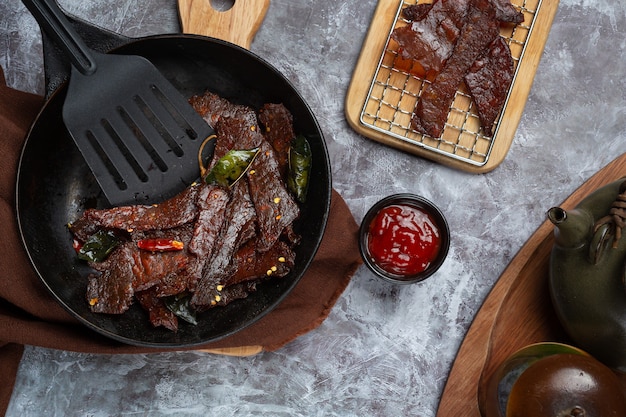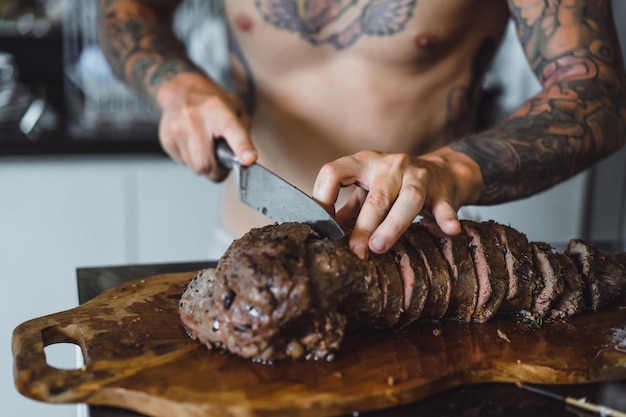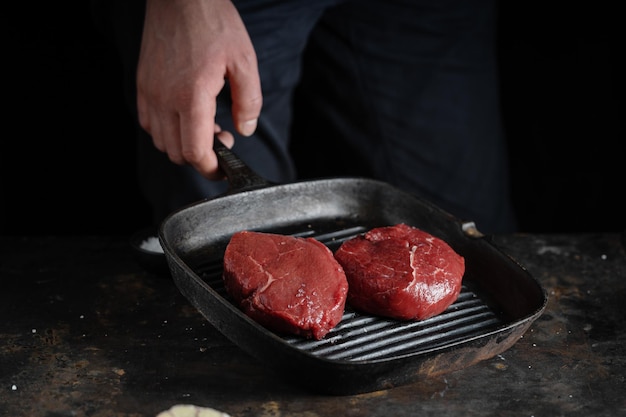There’s something about a perfectly cooked ribeye steak that just makes you feel good. It’s a meal that’s both satisfying and luxurious, a reminder that life can be truly delicious. And let’s be honest, it’s not just about the taste, it’s about the whole experience: the sizzle of the pan, the aroma of seasoned meat, the satisfying pinkness of the center, the juicy bite. I’m going to share all my secrets for achieving that perfect ribeye, from choosing the right cut to mastering the art of resting and presentation. Get ready to transform your culinary game, because this is going to be a journey worth taking.
(Part 1) Choosing Your Weapon: The Right Ribeye for the Job

Let's face it, not all ribeyes are created equal. Sure, they all come from the same area of the cow, but some are destined for greatness, others… not so much. We're aiming for greatness here, so let’s get picky.
Marbling: The Key to Tenderness and Flavor
Think of marbling as the heart and soul of a ribeye. It's the beautiful white streaks of fat that run through the muscle, adding that melt-in-your-mouth texture and a depth of flavor that'll make your taste buds sing. The more marbling, the richer and more succulent the steak will be. When you’re at the butcher’s, look for a ribeye that’s got a good amount of marbling, not just a few scattered streaks. Trust me, your taste buds will thank you for it.
Thickness: Getting That perfect sear and Juicy Center
A good ribeye is like a good book – it needs to have some substance. You want a steak that’s at least 1 inch thick, ideally 1.5 inches. This thickness allows for a beautiful, even sear on the outside, while keeping the inside juicy and pink.
Think of it like this: if you're cooking a thin steak, it'll cook too quickly and risk becoming dry and tough. A thicker cut gives you more time to get that perfect sear and allows for a more even cooking.
(Part 2) Getting Your Hands Dirty: Prepping the Ribeye

Now that you’ve got your weapon of choice, it's time to prep it for battle. We're going to take this humble piece of meat and transform it into a culinary masterpiece.
Pat It Dry: Kiss Those Excess Moisture Goodbye
First things first, pat that ribeye dry with paper towels. Any excess moisture will create steam in the pan and prevent a nice crispy sear, and nobody wants a soggy steak, right? So, give it a good pat, make it feel like it just stepped out of the shower.
Seasoning is Key: Flavoring Up Your Masterpiece
Here's where your culinary creativity can shine. I’m a simple guy, so I prefer to keep it classic with just salt and pepper. Freshly ground, of course, because the flavour makes all the difference. But, if you’re feeling fancy, go for a sprinkle of garlic powder, onion powder, smoked paprika, or even a touch of chili flakes. The key is to use fresh spices and to coat the entire surface of the steak generously.
Let It Rest: Give It a Chance to Breathe
Don't jump into the cooking right away. Let your seasoned steak rest at room temperature for about 30 minutes. This lets the meat relax and come to room temperature, ensuring that it cooks evenly throughout. Imagine it like this: think of it as a warm-up before a big game, you don't want to start cold!
(Part 3) The Big Show: Cooking the Ribeye

We've come to the heart of the matter – the actual cooking. This is where your skills are put to the test. No pressure, just remember, we're aiming for a beautiful sear on the outside, while keeping the inside juicy and pink.
Searing: The Foundation for Flavor and Texture
A hot pan is your best friend when it comes to cooking a ribeye. Get that pan ripping hot, and I mean screaming hot. Use a cast iron pan if you have one, it's perfect for retaining heat and distributing it evenly. Add a little oil, just enough to coat the bottom of the pan.
Now, gently place the steak in the hot pan and let it sear for 2 minutes on each side. Don't move it around, just let it sit there and develop that beautiful golden-brown crust. This is where the magic happens! You'll hear the steak sizzle, you'll see those delicious browning marks, and you'll smell that incredible aroma. Enjoy the moment, it's a thing of beauty!
Flipping the Script: Getting That Even Cook
After those first 4 minutes, it's time to flip the steak. Continue searing for another 2 minutes per side. We want a beautiful, even sear all around. Once you've achieved that, it's time for the next stage.
(Part 4) Time for a Change of Pace: Indirect Cooking
We’ve gotten our beautiful sear, but now we need to cook the steak through to our desired level of doneness. The key here is indirect cooking. This allows the steak to cook more evenly, preventing overcooking the outside while the inside is still raw.
The oven method: Consistency and Control
For the oven method, preheat your oven to 350°F (175°C). Transfer the searing steak to a baking sheet and cook for about 10-15 minutes for medium-rare. Check the temperature with a meat thermometer to ensure you achieve your desired level of doneness. The oven method is great for achieving consistent results and ensuring the steak is cooked evenly throughout.
The Grill Method: Smoky Flavor
If you're a grill master, the grill method is the way to go. Move your searing steak to the indirect heat zone of your grill. Close the lid and cook for about 10-15 minutes for medium-rare. Remember, the grilling time will depend on your grill's temperature and the thickness of the steak, so keep a close eye on it and use a meat thermometer to check the temperature. The grill method adds a delicious smoky flavor that can't be beat.
(Part 5) The Art of Rest: Let It Rest and Recover
You've done the hard work, you've cooked that ribeye to perfection, but the journey isn't over yet. Now, it's time for the steak to rest. This is not a moment of laziness, it's crucial for the steak's recovery and will ensure that the juices are evenly distributed throughout.
Ten Minutes of Bliss: Letting the Steak Settle
Transfer the cooked steak to a cutting board and let it rest for 10 minutes. Don't be tempted to cut into it right away! Just let it chill out, let those juices redistribute. Cover it loosely with foil to keep it warm. Imagine it like this: it’s just like us after a workout, we need a little time to cool down and recover before we can get back to our best.
(Part 6) Cutting the Steak: A Precise Operation
After its well-deserved rest, the steak is ready for its grand finale: the cutting. This is not about simply chopping it up, this is about presenting the steak in its best light. Remember, you've worked hard, you deserve to see the results of your labor.
Slice Against the Grain: A Key to Tenderness
Cutting against the grain is crucial for maximizing tenderness. This means slicing perpendicular to the muscle fibers. Imagine the muscle fibers as little ropes, you want to cut through them, not along them. If you cut with the grain, the steak will be tougher and chewier. So, take your time, admire the beautiful grill marks, and slice that ribeye with confidence.
(Part 7) A Feast for the Senses: Enjoying Your Perfect Ribeye
Finally, the moment of truth has arrived. It's time to enjoy that perfectly cooked ribeye. Your senses will be tingling, you'll see those beautiful grill marks, you'll smell the intoxicating aroma, and you'll taste the incredible flavor.
Presentation is Everything: Make it a Culinary Masterpiece
Now, let’s talk about presentation. It's not just about the taste, it's about the whole experience. Don't just plonk that steak on a plate, give it some love. Maybe add a side of mashed potatoes, some roasted vegetables, or a green salad. And don't forget the sauce! A simple béarnaise or a red wine reduction will elevate your ribeye to new heights. A beautiful plate of food will not only make your meal look more appealing, but it will also make you feel more special.
(Part 8) Temperature Guide: Finding Your Perfect Doneness
Knowing how to cook a steak to your desired level of doneness is crucial. Using a meat thermometer is the best way to ensure accuracy, especially for ribeye steaks, as they can be thicker than other cuts.
Here's a guide to the internal temperatures for different levels of doneness:
| Doneness | Internal Temperature (°F) | Internal Temperature (°C) |
|---|---|---|
| Rare | 125-130 | 52-54 |
| Medium-Rare | 130-135 | 54-57 |
| Medium | 135-140 | 57-60 |
| Medium-Well | 140-145 | 60-63 |
| Well-Done | 145-150 | 63-65 |
(Part 9) FAQs: The Burning Questions
1. What’s the best way to cook a ribeye?
A ribeye is best cooked using a combination of searing and indirect heat. This method ensures a beautiful crust on the outside while keeping the inside tender and juicy.
2. What’s the best cut of ribeye?
Look for a ribeye with good marbling and a thickness of at least 1 inch. A well-marbled ribeye will be more flavorful and tender.
3. How long should I rest a ribeye?
Resting a ribeye for 10 minutes after cooking allows the juices to redistribute throughout the steak, ensuring a more tender and flavorful result.
4. Can I cook a ribeye in a skillet?
You can definitely cook a ribeye in a skillet, but it's important to ensure that the skillet is extremely hot and that you have enough oil to coat the bottom of the pan. Use a heavy-bottomed skillet, like cast iron, to help retain heat.
5. What are some good sides for a ribeye?
A ribeye steak pairs perfectly with a variety of sides. Some classic pairings include mashed potatoes, roasted vegetables, asparagus, green salad, and creamed spinach. Don't be afraid to get creative!
There you have it, the ultimate guide to perfectly cooked ribeye steak. Now, go forth and conquer! Remember, practice makes perfect, so keep trying and experimenting until you find your perfect technique. And most importantly, enjoy the process! It's about more than just the end result, it's about the journey, the satisfaction of creating a culinary masterpiece.
Everyone is watching

How to Cook Frozen Lobster Tails Perfectly: A Step-by-Step Guide
RecipesLobster. Just the word conjures up images of lavish meals, special occasions, and a taste of luxury. But let's...

Pigs in a Blanket Cooking Time: How Long to Bake for Perfect Results
RecipesAh, pigs in a blanket. Just the name conjures up images of those delightful little parcels of crispy pastry en...

Pork Fillet Cooking Time: How Long to Cook It Perfectly
RecipesPork fillet, or tenderloin as it's sometimes called, is a real favourite in our house. It's so versatile, and...

The Ultimate Guide to Tender, Juicy Pulled Pork
RecipesRight, let's talk pulled pork. It's one of those dishes that just screams "comfort food," doesn't it? I mean...

The Ultimate Guide to Cooking Sweet Potatoes: From Roasting to Mashing
RecipesSweet potatoes. Just the name conjures up images of warm, comforting dishes, bursts of vibrant color, and a to...
